How To Build A Standardised Sales Process
- Home
- How To Build A Standardised Sales Process
This is a transcript of the talk at the HubSpot User Group (The London HUG) meeting in April 2019 by Brian Sexton a Principal Channel Account Manager at HubSpot in Dublin.
I have been working in HubSpot for about five years now, when I first joined HubSpot I started in business development. Predominantly I have been doing a lot of the initial conversations with prospects.
I'm going to take a different approach to talk about the flywheel. I'm going to reference a couple of examples that I use as part of my own sales process and other sales reps in Hubspot over the years.
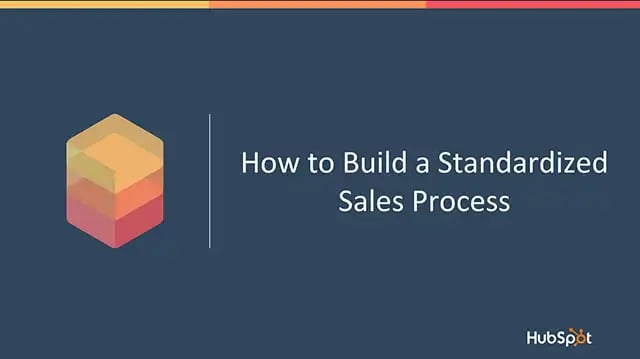
Your business needs a sales process
I'm going to start with why every business should have a sales process and the disadvantages of not having a sales process in the first place. Also, we will spend time looking at prospecting. Prospecting is the initial engagement. The very first conversation that every prospect has with the first point of contact in that given business. I'm going to look at the sales process from my perspective, we'll be covering five specific stages from the very first interaction to the point that you send a quote or send an activation link.
I'm going to look at a couple of sales metrics that every sales professional should be familiar with. If you haven’t done it, I'm going to highlight the reasons why you should do it.
"Everyone should adopt a sales process because it's predictable and scalable."
For a growing company like Hubspot, there are specific playbooks that we have provided kind of with to ensure that he has set up for success. These are playbooks based on the sales process, their playbooks based on the various stages that he should begin to take prospects through. The second part of this is it's very easy to measure what works and what doesn't work.
I think at the last HUG you spoke about marketing campaigns, onboarding how long is HubSpot onboarding and questions like testing. People may A/B test specific campaigns. You should do very much the same thing when it comes to running a sales process. You need to figure out as part of any sales process what works and what doesn't work. You need to document it and then you need to give feedback to the team.

One of the things that we do when we have our weekly team meetings is each sales rep will get an opportunity to stand up and present something that worked from a sales perspective the previous week or vice versa. There are many things that you should begin to adopt or it could be towards the end of the sales process when it comes to running a demonstration.
It could be a couple of questions that you should ask the prospect.
It's easy to filter out bad or fit prospects. Prospecting is probably the hardest thing when it comes to selling, in my opinion. We know the product and service that we're trying to sell. But the hard part is actually to engage and reach out to people.
Pre-defined sales stages
The other thing is that the sales process enables you to spend time with the right people. There are several specific stages and at any point in time, you can either tell the prospect that you don't think this is a good fit for A, B and C reason or the prospect doesn't think Hubspot is a good fit for me because of A, B and C reason.
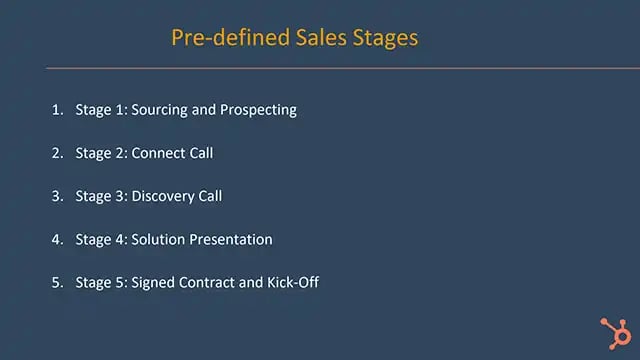
You've always allowed the prospect and yourself to opt-out.
Last but not least, it's a simple structure of a pleasant buying experience for the customer. I as a buyer, I have a pretty high action threshold. I'm probably the worst person that you want to be speaking to if I was buying your product for the simple reason that I probably see the negative side of things. I see the cost, whereas someone with a low action threshold very much sees the benefits or the success of that product or service. So in my opinion, one thing that I want as a buyer is I need to understand what is the process that he or she may take me if it's a case that product service is a good fit for my business.
Prospecting
"Prospecting is probably the hardest part when it comes to selling. 50% of sales time is wasted on unproductive prospecting"
What that means is people are spending time researching in the wrong areas that are prioritising their leads. They're not preparing and incorporating into Hubspot. This is the algorithm, that we've built:
- Researching your lead
- Identifying who your buyer personas are
- Making sure you're speaking to the right people
- Identifying the geo-location that you're looking to target
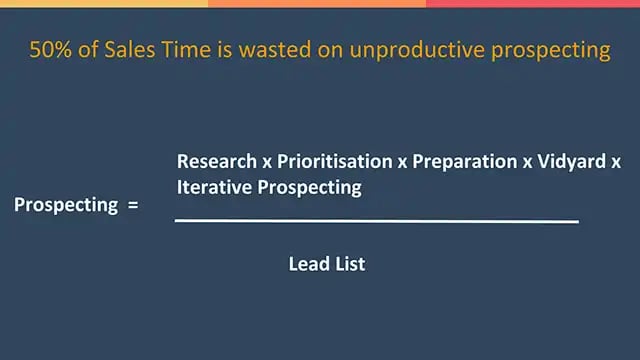
Research
If you research a database of a thousand contacts, how do you even begin to prioritise? Do you reach out to this leader that leads, whatever it may be?
Preparation
Calling blocks
One thing that we do internally. One of the things that I always did was call blocks.
I had a specific calling time where all I do is put the headset on and I will call and email on an ongoing basis. I did most of my sourcing in the morning for an hour. Then I will take two hours to catch up on emails and get ready for the afternoon.
Typically I will have a two-hour calling block as part of the prospecting in the afternoon. Divide the lead list based on who's a good fit, and who's not.
The prospecting funnel
In the same way, you have a marketing funnel, this is the prospecting funnel. At the top, you're trying to identify who you need to speak to, who’s a good fit, who’s a bad fit company. The worst thing that you can do is identify a database of leads that aren't a good fit for your products or service and then begin to add them or import them into the CRM.
Document your sales process
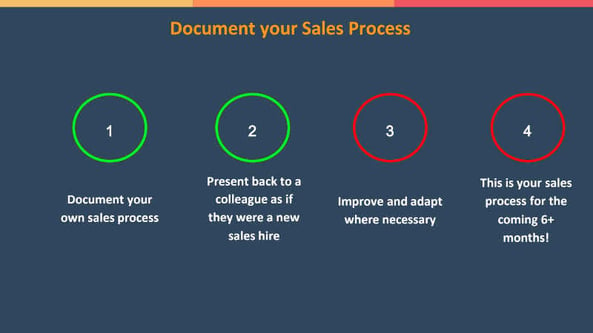
When it comes to the prospecting piece, this is where you're proactively engaging with prospects. You're picking up the phone, making sales videos, sending emails, or dropping LinkedIn emails.
"I used to give myself a goal every day to send five emails to five different business owners"
You're having conversations, trying to qualify someone in or out. And you're trying to identify whether or not they have a problem before we even think about positioning Hubspot as a solution or the partner program as a solution to the challenges. Then it's a case of selling. The idea is that you've identified that they are fit, and they have a problem.
"Now it's a case you should be going to provide value based on whatever products or service you sell"
Managing the sales process
In terms of managing the leads and the process, these are a couple of things that I think every sales professional should be familiar with. For a qualified lead, you need to ensure that you have a set time and place to call them back.
"It is good to call qualified leads within the first half an hour"
This is what we say to ourselves internally if we get a qualified lead.
For example, this is someone who is looking at Hubspot or one of our ebooks. If they have viewed a specific page, or pricing page, requested an inbound marketing assessment, or requested a demonstration. Then that is a qualified lead, in my opinion. I need to ensure that I can get back to them in time. One of the things that I do is I have several CRM views built into the Hubspot CRM that I rely on day in, and day out. A lot of my partners had the same views and built it for themselves.
I have views built out for recent visits, this could be across the board. And based on that visit, we'll dictate whether or not, that person is worth a call or he needs a little bit more nurturing or emails. Every single Hubspot sales rep will get a notification, an email directly into the inbox stating this information. A person from this company has visited the pricing page in addition to the email it will provide me with a couple of resources that I should share with the prospect as part of their evaluation of Hubspot.
Recent QLs (qualified leads) are things that we have internally in Hubspot such as an SQL (sales qualified lead), and a PQL (product qualified lead). These are existing Hubspot customers, and existing users using the free software. Essentially putting their hand up and saying, I want to evaluate this further. They're the key that everyone should look to incorporate into their sales process today if you haven't already done so.
Sales automation
The product prospecting is the idea of leveraging automation. I think I'll be the first one to admit when I first heard that sequencing is coming out, I was a little bit of apprehensive about it. For the simple reason that all I'd ever known was call and email.
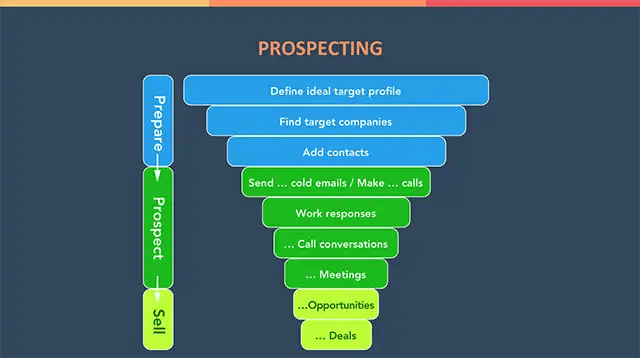
My approach was what does this mean or what will this lead me to? Does it mean that every single lead comes in, you're just going to assign them into a sequence? And then hopefully wait for that prospect to book time with you directly. As part of the prospecting sequences, I have several sequences.
Sales sequences
I have a sequence for recent visits, so I can approach the person and thank that person for visiting the Hubspot website today. It's based on tokens, so it's all personalised. It will reference whenever eBook or page they viewed. Then approach that person but maybe after two days there are no replies, maybe drop in another email asking: Are you sure you don't want to have a conversation with me? Then maybe four days later, it may get some type of soft breakup. It could be along the lines of "I've reached out to you several times over the last couple of weeks or last couple of days. You haven't got back to me. I'm assuming this is not of interest to you anymore."
Getting started with HubSpot
Last but not least, we have another one for getting started with Hubspot. We have a getting started with the Hubspot page, automatically we have a sequence that we can assign users into that. It's all based some time management and how much time can you allocate to doing this. Business development representatives, you need to have specific calling blocks in the calendar where you focus on your CRM views and prospecting sequences.
You can do that at any point in time. I may do that kind of first thing in the morning. I'll just go to recent visits, see and that clicked getting started to Hubspot. While I'm on site here today or while I'm coaching partners all these sequences are happening in the background. Hopefully, when I check my inbox later on today, I'll have several people who will want to speak to me and have requested a meeting. So make sure you can manage the leads to make sure you manage the process and begin to think about building its views.
Video prospecting
I use video and I'm at the stage where I will reply to an email with a Vidyard video because it's easier and it's probably a little bit more laid back. Everyone is on their phones any time of the day. That's why everyone is on the phone reducing cold prospecting and the prospecting barrier. It's quite disruptive and it is a completely different approach. The other thing about it is that not everyone is doing this yet.
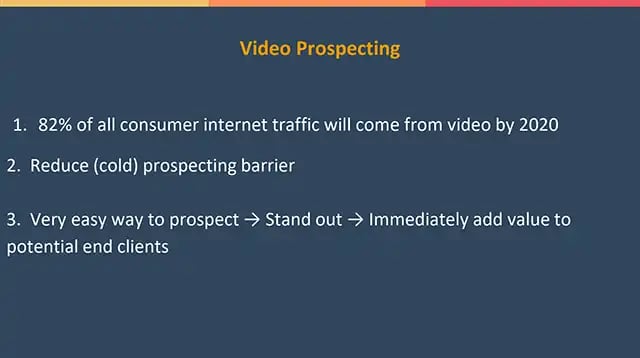
"There's a huge opportunity for you to begin to use video as part of the sales process"
In the prospecting piece, you're putting a face to the name from the moment you reach out. And you can make it very personal, and it’s an easy way to prospect stand out. You can add value straight away to potential leads. If anyone is not comfortable behind the camera then start doing cards and send it amongst yourselves as an internal team to get comfortable with it.
My typical video would be something like “It's Brian here from Hubspot. I noticed you were just on the website and requested a demonstration. But first, let's have an initial conversation at some stage this week and off the back of that, we can look to schedule that in and I'm going to include my meetings link in the calendar invite or in the email and feel free to book time with me.” That's it.
"Keep it short and sweet"
Continue to do this as more and more businesses are going to adopt this software. You have it directly within the system and the prospecting sequence. The idea is that if you think of a lead list. You're going to have good leads, mediocre leads and bad leads. As part of that, you need to ensure you push whatever lead is true.
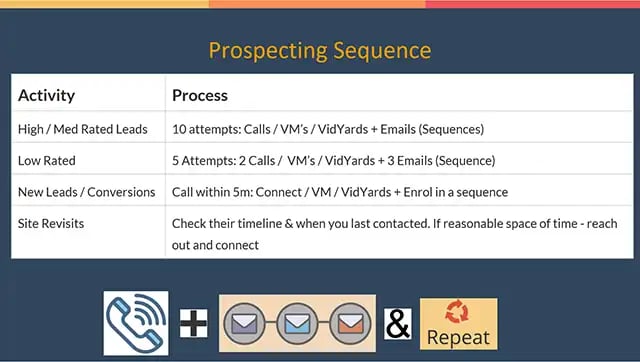
We have an approach whereby depending on how you categorise the lead, it will dictate how much time I allocate to that person. For example, for anyone who is a low-level lead, I'm only going to reach out to them five times. I make two calls, leave two voicemails, send a video and maybe send one or two emails.
If my approach is based on the time that I have, I will typically leverage sequences for any of my low-rated leads. These are people who may not be the decision-makers in the business. That company may not be a fit for Hubspot based on the product or services selling.
In terms of where I allocate my time the likes of these people. So any high or medium needs and what I have is kind of a process whereby it's a five-step process, which I'll go through on the next line. The other thing when it comes to prospecting, is that a no is as good as he?
For example, if I speak to Andrew and Andrew is a prospect and he says, Brian, I'm not interested, that's fine. We'll part ways as friends and I'll spend my time looking for the next prospect who potentially I can help. That's always the attitude that we have in-house, which is a no is as good as a yes. You can't help everyone.
Be smart with your time
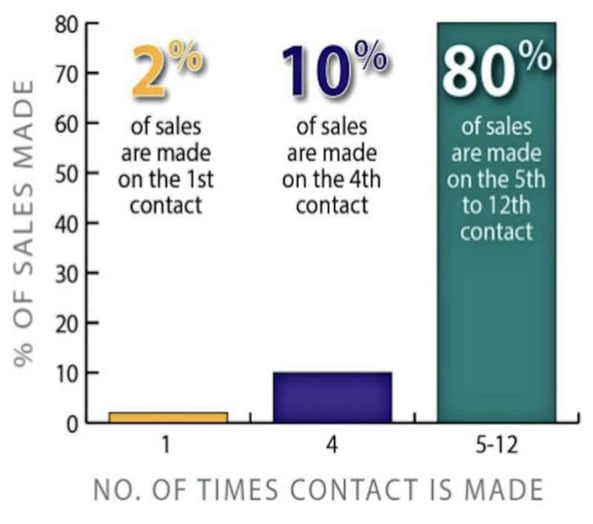
This is what I was kind of referencing in terms of you need to be smart, be smart with your time. 2% of sales are made on the very first contact that a sales rep has with a user or a prospect. These are essentially people who have reviewed your product, service, and they're at the stage where they know they need whatever product service that is. 10% of sales are made on the fourth, and then:
"80% of sales are made on the fifth to 12th contact"
The break-up email
The highest, the best response that we get is emails in-house and Hubspot is the breakup email. Such as: Hey Andrew, I've told you several times over the last two weeks. I haven't heard back from you. I'm gonna assume that this is not something you want to discuss. That's it. And typically Andrew may come back with either a yes or a no. From my perspective, that's all I'm looking for.
The sales process
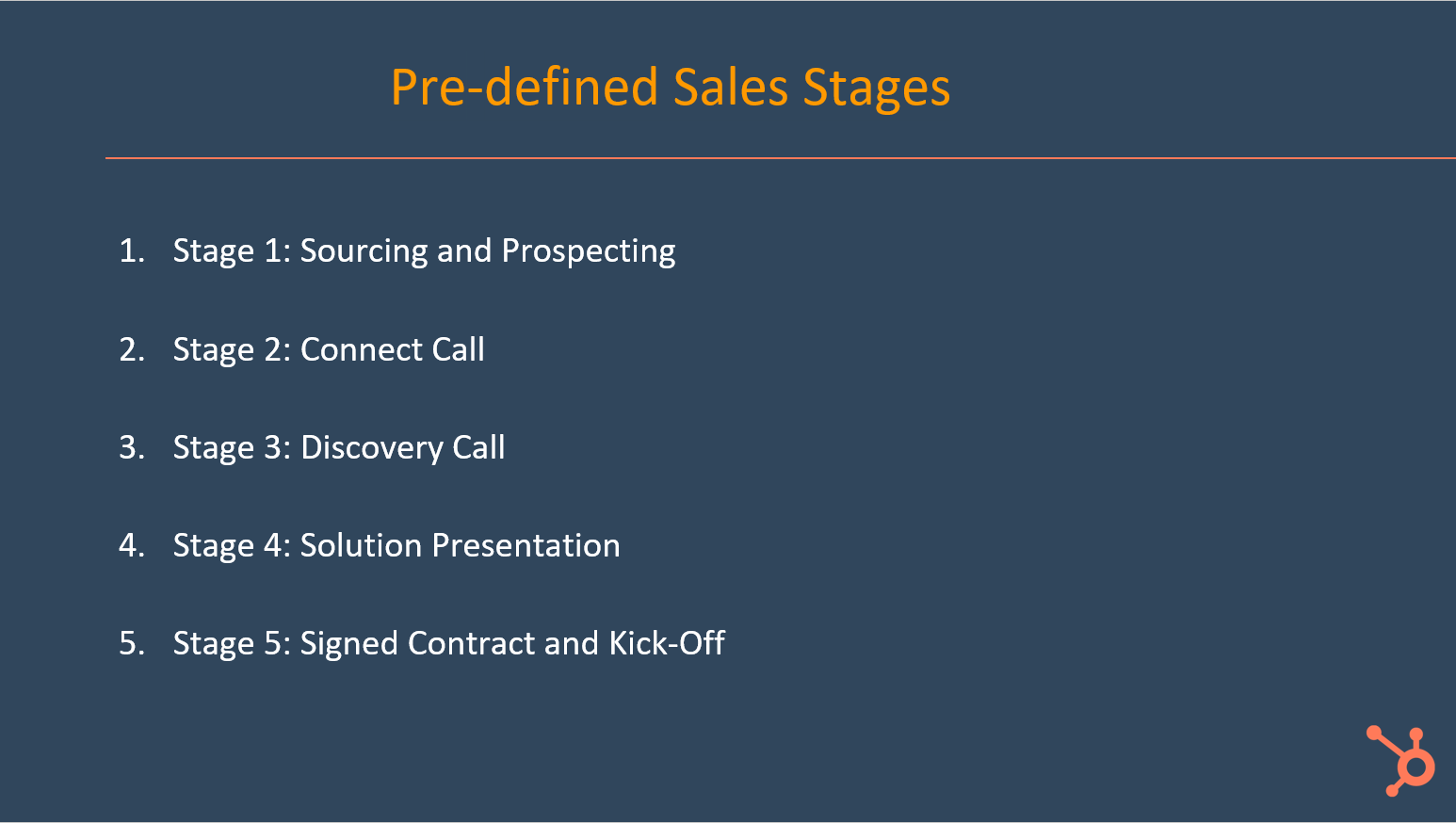
I'm going to spend time looking at a couple of specific stages in the sales process. These are all stages that we adopt in-house.
Stages in the sales process
I'm going to look at:
- Sourcing
- Connect called
- Discovery called
- The solution presented presentation or demonstration
- Signing a contract.
It's just a free Google Chrome add and it will tell me that the company is using Marketo Eloqua or Google Analytics. Obviously, decide who you want to begin to spend time with buildup a continuously strong pipeline. For a lot of people that's coming up to summer, summer means holidays.
"Holidays typically means that you need to double down on your prospect and your activity three to two weeks before that"
One of the biggest things that I used to do is to have weekly dedicated time to sourcing and prospecting and I would encourage you to do it as a team.
There was a lot more on that slide, but we had a thing which was we would not go for lunch until we were the top two from an activity perspective in Hubspot in Dublin.
And that was kind of one of the metrics that we used to ensure that we were doing the work, the appropriate level of prospecting, to ensure that we were staying ahead. Assuming you put in the input, the output will come at the end.
The connect call
The connect call is the very first engagement and interaction that you will have with a prospect. Typically it's short, so it's only 10 to 15 minutes and you're simply trying to identify:
- Who you're speaking to
- Do they have a problem
- Are they looking for help
They're the three things that I look for to qualify someone in or out at the end of the Connect call.
Is the business a good fit?
As much as Hubspot may be a fit for the business, is the business a good fit for Hubspot? Credibility and trust. One of the ways that I do, when it comes to that is before I have a connect call with anyone. I will always go on to their LinkedIn profile and I'll scroll back to one of their previous roles.
For example, if I were speaking to a marketing agency, I may speak to Helen and say, “Helen, you’ve been the founder of the agency for x years. I was just checking you out on LinkedIn and I noticed that 20 years ago or 10 years ago, you used to do x.” You're trying to find something that you can break down the barriers because remember people like to talk about themselves as well.
If I find something that Helen is interested in, hopefully, she'll start talking about it. I'm showing that I'm different in terms of my approach. I'm not just going straight into a pitch and then hopefully we can identify whether or not Helen has a problem that I can solve. Identify any challenge, periphery, or quantified, like this will not happen all the time.
Bear that in mind, there are very few connect calls that a salesperson may have whereby the prospect just gives them everything, their problems, challenges, revenue numbers and everything. You need to ensure that you're least trying to get a sense of it. Typically that will happen at the next stage.
Prospect homework
This is what I do for every single prospect that I take to the sales process. There is specific homework or specific things that I need from the prospect for them to get to the next stage or call me. I'll use this as a way to qualify people. From my perspective, if someone is not willing to spend five minutes filling out a questionnaire, are they willing to spend money on Hubspot in the first place? I send that to the prospect and it has to be completed before I go to the third stage, which is the discovery call.
I would strongly encourage everyone to think about incorporating some type of homework into your sales process because it gives you information that gets something in return. Then the outcome scheduled discovery call or your parting ways. I will always say at the start of the connect call, that I may sell something like peace and just to set the expectation. Two things typically happen at the end of this call:
- one, we either look to schedule our next step call, which we can do at some stage this week. Or
- we may look to part ways as friends. If it's not a fit from your end or my end.
Typically the prospect is satisfied with the outcome. Because they know what they're in for, what's going to happen and an opportunity to update if they don't want to speak to me anymore.
The discovery meeting
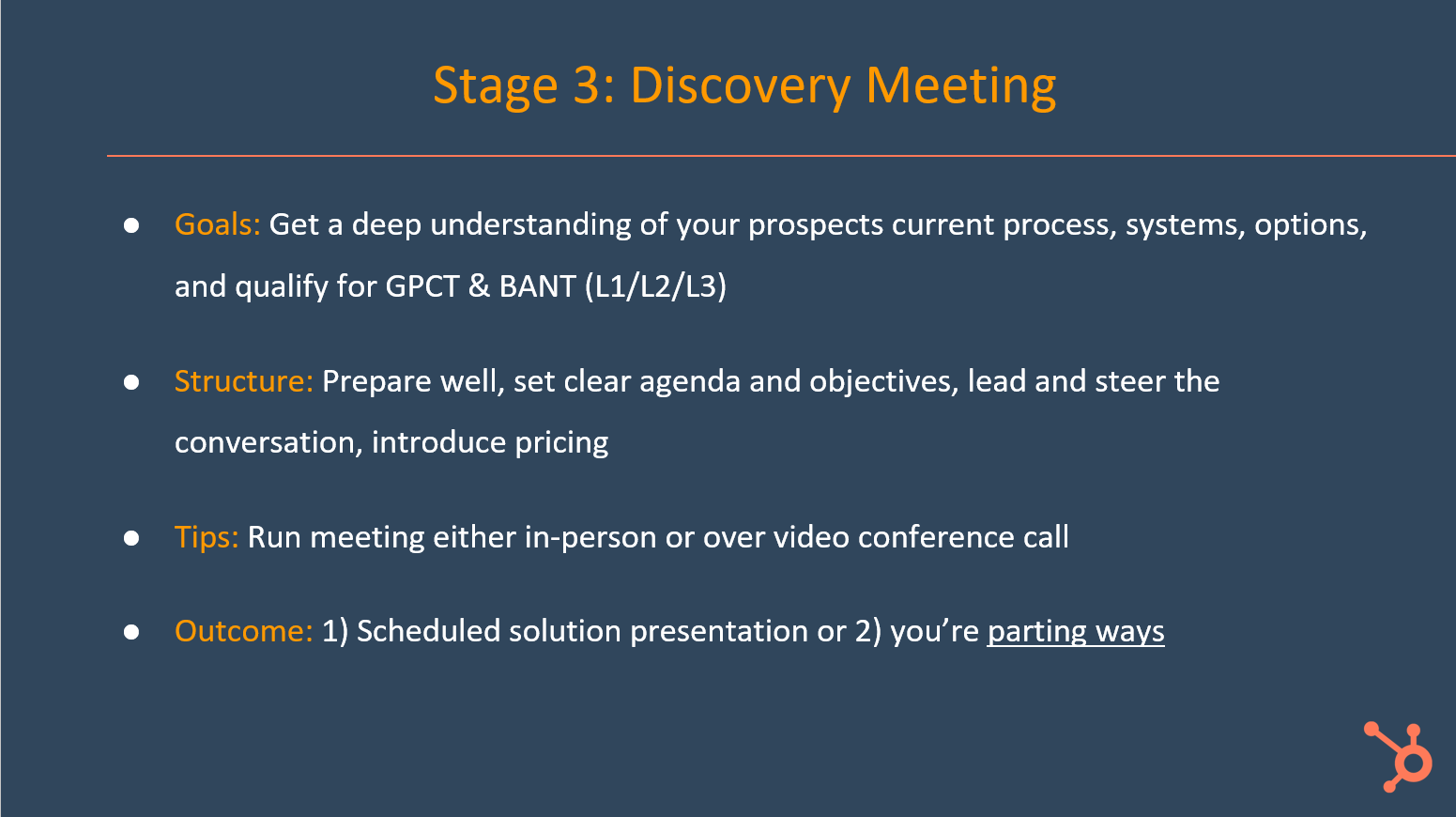 The discovery meeting is typically where you do the bulk of your selling. It's the opportunity. It's the step where you provide value and identify to what extent you can help the prospect in question.
The discovery meeting is typically where you do the bulk of your selling. It's the opportunity. It's the step where you provide value and identify to what extent you can help the prospect in question.
- Goals
- Plans
- Challenges
- Timelines
- Budget
- Authority
- Need
- Timing
One of the mistakes or pitfalls that any sales rep will make is, what are your goals for 2019? The prospect may say, I'm looking to increase revenue by 10%. So the sales rep says, sweet, got the goal onto plans. I level to goal as a timing to it. So I want to increase revenue by 10% by the end of Q two 2019 and a level three goal is one increase revenue or 10% by the end of 2019. If I don't, I'm not in a position to hire two additional salespeople for 2020, so why can't I say every salesperson will get level one?
"The good salespeople will get to level two and the great salespeople will get level to level three"
Don't just take someone's word for it in terms of I want to increase revenue, what happens if you don't hit 10%? How much did you grow last year? Prepare, you're setting your clear agenda. Always steer the conversation and be super transparent in terms of what is going to happen during the discovery call. It's probably around 60 minutes but it completely depends on the value of the transaction or product or service that you're selling. Some people will go face to face and have like an in-house discovery call with them.
Pricing strategy
Introduce pricing. Why never bring someone to a demonstration until they are familiar with or aware of the Hubspot pricing? At the end of the discovery call, I may say: have you had a chance to see the pricing page? Regardless of what they say, I will take them to the pricing page and based on what product and service they're looking at, I will give them an accurate breakdown of the costs. If I was buying, I don't want to be left in the dark. Always introduce pricing and if the pricing is not fit, we can either schedule the demo or we'll part ways as friends. Easy for them to update, and easier for me to opt them out based on whether or not they don't meet the criteria.
The solution presentation or product demonstration
A solution presentation or demonstration. At this stage, you've identified to have a problem. Now it's a case that you can truly begin to sell the solution. Focus on the order of the process. If someone has a problem, then they're a fit for the solution. You’ve added value and handled any questions they have and the structure of it. From a services perspective, you may have delivered particular deliverables you need to deliver.
Make sure the prospect is at the stage where they know exactly what's going to happen. Sometimes a question that I may ask if I run a demonstration at the very start, I may say:
"If this goes well, what happens then?"
I'll see what the prospect says. I'm trying to get a sense of to what extent am committed to evaluating the solution in question. Do the presentation on-site, face to face for anyone doing proposals. One of the pitfalls for any agencies that we have here that I've seen in the past is essentially agencies sending over proposals online and not walking into a prospect. What's involved, the deliverables, the expectations, etc. You're going to move on to the closing call or you're going to look to part ways as friends.
Closing the deal
Sending the official quotation or getting the prospect to sign there. And then depending on whatever the process is you have a couple of things to do. You've outlined the products. If I am buying anything, I like to know what happens post-purchase. If ever I get to the stage where I'm on the other end.
One thing that we encourage everyone to do is create a template that is easy to reuse. There's a lot of time that goes into creating a proposal for any product or service. We'd encourage people to begin to have a template that you can use to replicate.
Last but not least, what's going to happen? Either they're going to sign the contract, you'll have an official start date in place or you're going to part ways as friends.
Sales metrics
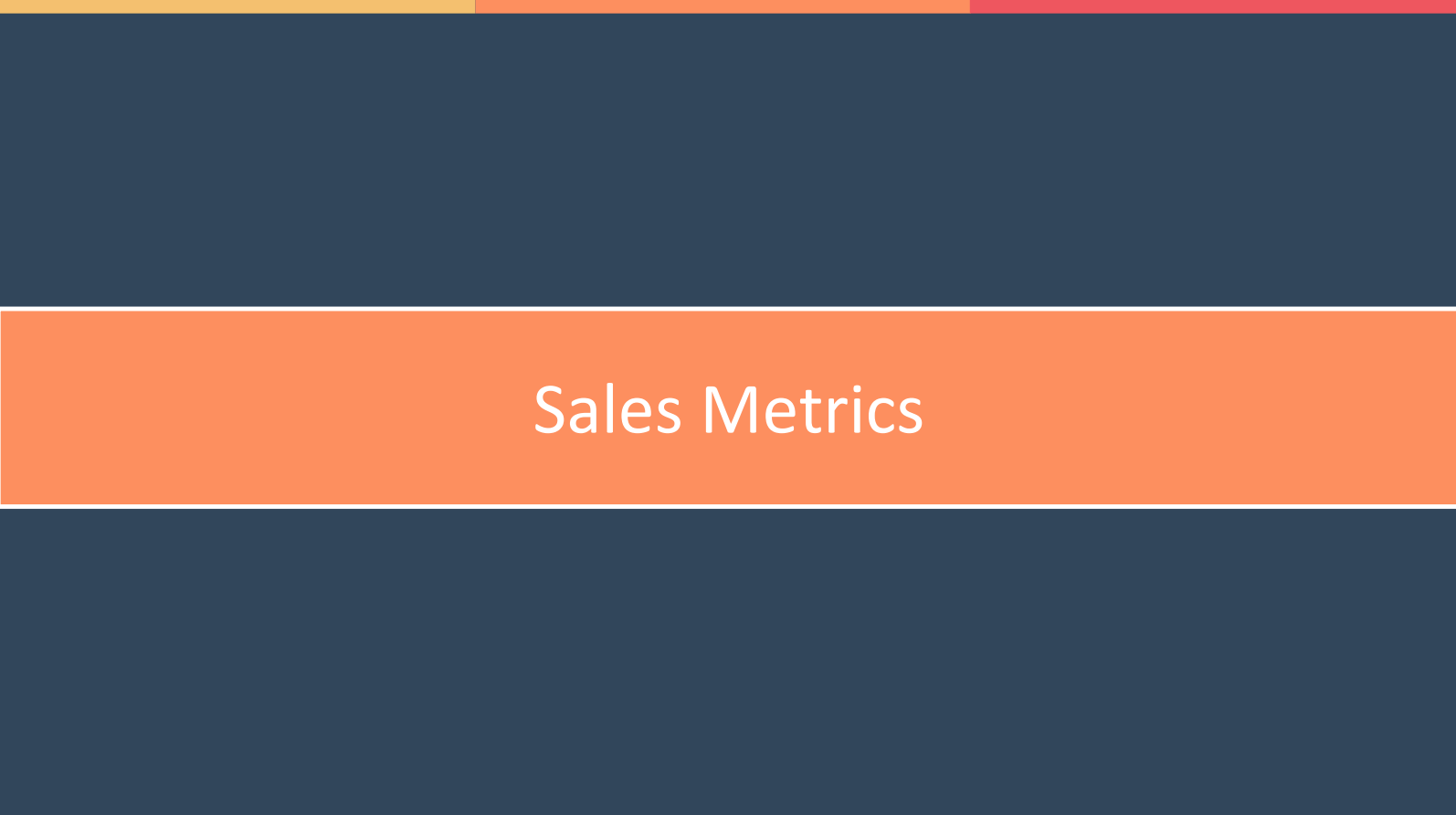
Sales metrics. A couple of key metrics at every sales professional needs to be very familiar with. The start of it is looking at your conversion rate, this is something that does not happen overnight. This is something that you need to probably do for, a quarter or two quarters. Get a sense of if you as a salesperson, get a hundred leads, how much business will you tell us from that? For instance, sales funnel. These are a hundred leads of which not all of leads want to speak to you. Not all of these leads are a good fit.
Sales conversion rates
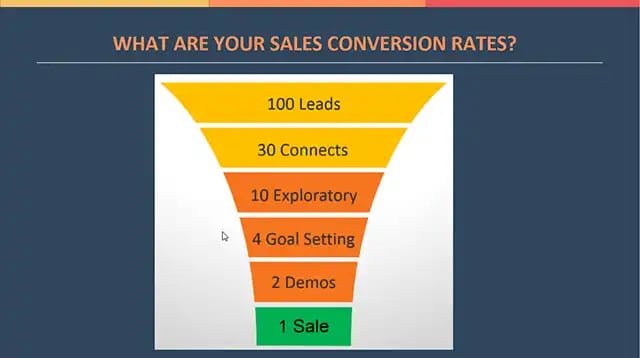
You'll have 30 connect calls. What are you looking for help with? Is this something you're looking to fix? How long have you been evaluating x provider? It's brief, short and sweet. Trying to qualify someone, probably 30% of those who make it to the exploratory call. Just because you have a sales process in place doesn't mean that everyone has to go through the entire process.
If I was to demo Hubspot to every single person who wants a demo, I'd be on the phone all the time. I'd have 10 exploratory calls. You may get to kind of for a goal setting calls. Out of those you may get to two demonstrations and for anyone who was demoing software, you're typically looking at the very least for a one or two close rate. If your demo is to two people at least more proceed and activate.
If you don't have it, you probably need six months to get an accurate view. If you get a hundred leads, how many of those will be close? These are a couple of dashboards that I use in-house. We have a deal forecast by the owner and see a wide variety. These could be all the individual sales reps, the different colours correspond to the various products and services that they are selling. You also have deal stages. You can customise that within the Hubspot CRM. Don't just take this as standard, but that could be the typical sales process that people may try and qualify people. Deal forecast from an ownership perspective, what are you forecasting based on closing it within the given month?
B2B sales pipeline
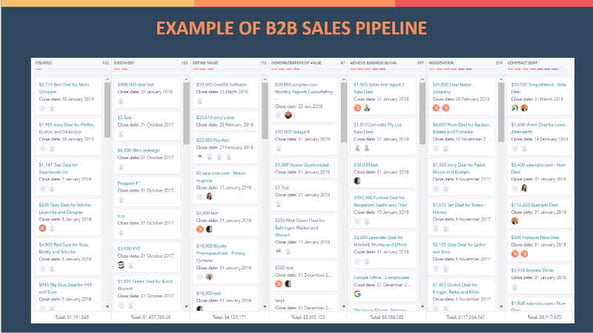 Here's an example of a BDB sales pipeline. The idea is that the first thing you'll do is you will define whatever your stages are. You will qualify that prospect, you will create an opportunity. That opportunity will initially sit here before you move it to discovery. Discovery is the 60-minute call with the prospect. Based on what happens after the discovery, you may move it to various stages of the funnel. You might have one here for demonstration. If I move someone from here to the demonstration, I'm going to move them there.
Here's an example of a BDB sales pipeline. The idea is that the first thing you'll do is you will define whatever your stages are. You will qualify that prospect, you will create an opportunity. That opportunity will initially sit here before you move it to discovery. Discovery is the 60-minute call with the prospect. Based on what happens after the discovery, you may move it to various stages of the funnel. You might have one here for demonstration. If I move someone from here to the demonstration, I'm going to move them there.
These are things that I always populate when it comes to moving an opportunity forward. One is our next step. It could be something like that or it could be the salesperson to follow up with the prospect. I will then create a task and then follow up with them.
Then the other thing I do is update the next step date because anything that's in the past, it shouldn't be there.
The final thing is revenue. I will populate the opportunity records, the corresponding, products they're looking at marketing, sales, and service.
Takeaways
The 120-day prospecting cycle
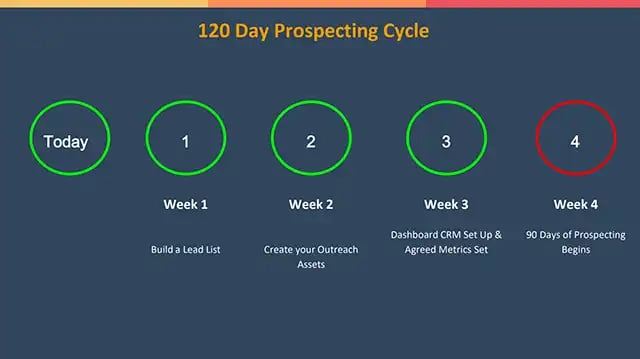
This is the 120-day prospecting cycle. First, you need to build out a lead list.
Wherever you get that list from, you need to identify that they're good fit prospects based on the research you've done. They're interested or are looking to evaluate your product or service.
Filter your leads
Any assets that you will use as part of the prospecting piece. Your various stages create specific views for you as a sales rep. In the Hubspot CRM, you can filter to see specific views for your pipeline or leads. These are metrics amongst the sales team as a whole. For any sales managers, what are the specific conversion rates that your team are closing?
At week four you start 90 days a prospect and so that's 12 weeks of prospecting the database that you've identified is a fit or not. You would give a chance to other reps on the team to speak of what's working, and what's not and share specific examples.
Document your sales process
And if you think of scaling your business, you need to have a document or a process that you can hand over to a new sales rep. Documentary on sales process then the homework is you present it back to a colleague as if they were a new hire BDR (business development rep). Almost pretend that he or she knows nothing about the sales process. In the things we do in Hubspot, we will have an interview and we will set up meetings with the most successful sales reps from a channel side and direct side like an interview. What's working, what's not, any pitfalls that you've seen over the last couple of weeks? This is your sales process for the coming six months.
Success in sales
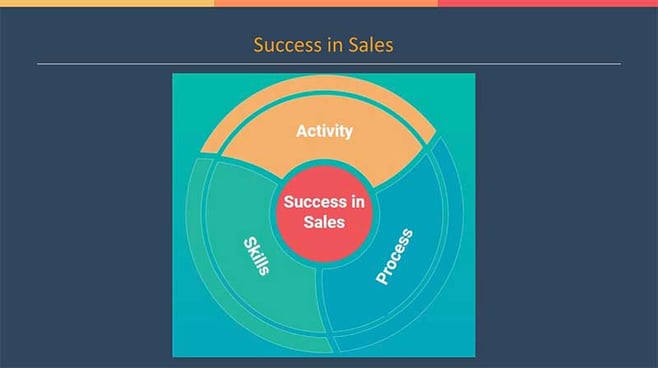
I've built my flywheel, but it's a sales flywheel. The idea is that for any sales professional, three areas need to ensure that you're all over. The first is your activity. It all starts at the top, which is generating engagement. Any type of method that you can think you can incorporate into your sales process. I've been at Hubspot for five years, but I'm constantly trying to improve and asking other people what's working, and what's not.
You need to make sure you're open to that. Then processes, I've walked into a couple of my processes and you need to have those documented. You need to be willing to adapt to them based on what's working, and what's not. But in my opinion, if you have a high level of activity, constantly looking to improve and do better. A successful career in sales for those that are in us or for people that are looking to branch into it.

